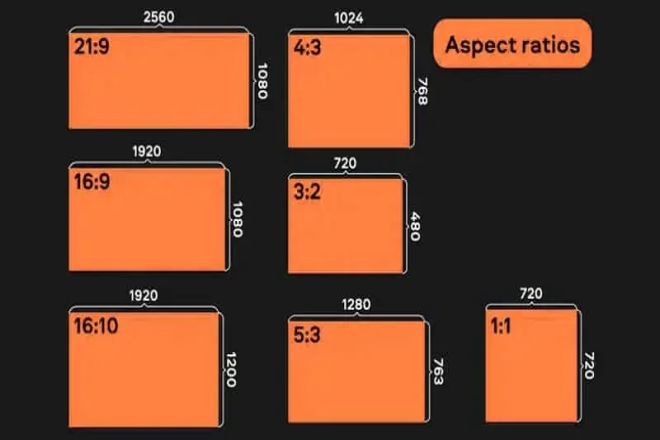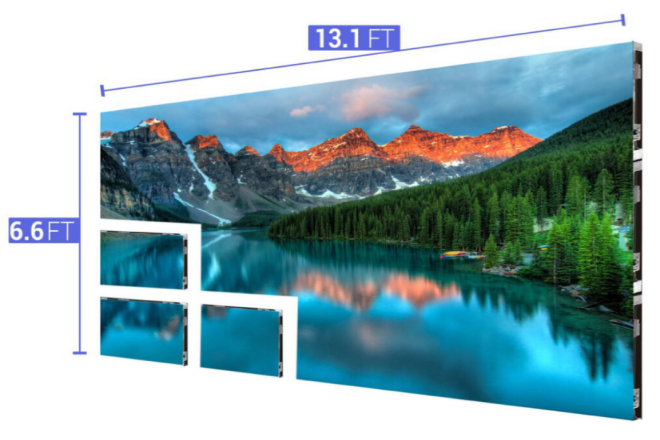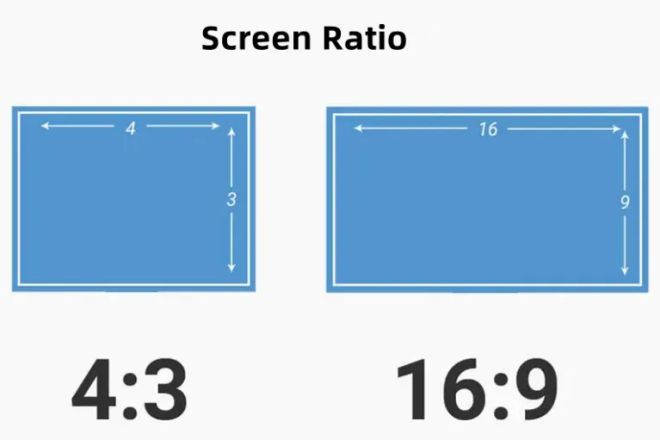Introduction

Whether it is commercial advertisements, sports events, conference reports, or public information, LED display screens play an irreplaceable role with their unique advantages. Among the many technical parameters of the LED display, the aspect ratio is undoubtedly a crucial factor.
Do you know the aspect ratio of the LED display? This article will specifically explain the aspect ratio of the LED display.
1. The concept of the aspect ratio of LED display

The aspect ratio of the LED display, in short, is the ratio of screen width to height. As we often say, there are lengths and widths, and the aspect ratio describes the relationship between the length and width of this rectangle.
When we talk about the LED display, the aspect ratio is a very critical parameter that directly determines the shape of the display screen and the display mode of the picture.
Imagine if you have a rectangular box that is twice as long as wide. Then we can say that the aspect ratio of this box is 2:1. Similarly, the LED display also has a fixed aspect ratio, which determines the width and height ratio of the image or video content displayed on the screen.
Why is the vertical and horizontal ratio so important? Because it is directly related to our visual experience when watching the screen. If the aspect ratio is not appropriate, the image or video may be stretched or compressed, resulting in the deformation of the picture and the loss of its original beauty.
For example, if a movie with an original widescreen is played on an inappropriate aspect ratio, the picture may appear too flat or too slender, affecting the viewing effect.
When we choose the LED display, we need to determine the appropriate aspect ratio according to the actual use needs.
For example, if you are used to playing high-definition movies, the 16:9 display will be a good choice, and if you need to display some documents or pictures, you may need to choose the appropriate aspect ratio according to the characteristics of the content.
2. What are the common aspect ratios of LED displays?

The aspect ratio of an LED display is a key technical parameter describing its shape and image presentation, which directly affects the audience’s visual experience and information transmission effect.
Different aspect ratios correspond to different display requirements and application scenarios. Next, let’s explain in detail several common LED display aspect ratios.
- 16:9 aspect ratio:
This ratio is very close to the field of view of the human eye so that it can bring a more comfortable and natural viewing experience.
The 16:9 display screen is widely used in high-definition TVs, cinemas, and most computer monitors because it can perfectly present the aspect ratio of high-definition video content, making the picture wider and more delicate.
- 4:3 aspect ratio:
4:3 is also a common LED display aspect ratio. This proportion is relatively traditional. In the early days, it was widely used in TVs, computer monitors, and other fields.
Although with the popularity of high-definition video content, the 4:3 display screen has gradually withdrawn from the mainstream market, the 4:3 display still plays its unique role in some specific application scenarios, such as some old-fashioned video content playback or the display of specific needs.
In addition, there are some other proportions of LED displays, such as 15:9, 16:10, etc. Although these ratios are not as common as 16:9 and 4:3, they also have unique application value in some specific situations.
For example, for some application scenarios that require multiple information windows to be displayed at the same time, a wider 15:9 display may be selected; for some occasions with special requirements for the height of the picture, a slightly higher 16:10 display may be selected.
It should be noted that when choosing the aspect ratio of the LED display, not only the beauty and coordination of the picture should be considered, but also the adaptability of the display content and the viewing habits of the audience.
If the content displayed is a high-definition video or a widescreen movie, it is more appropriate to choose a 16:9 display screen; if the content displayed is mainly documents or pictures, it may be necessary to choose the appropriate aspect ratio according to the specific content characteristics.
3. How to choose the LED display aspect ratio that suits you
Choosing the appropriate LED display aspect ratio is a process that requires comprehensive consideration of multiple factors. Here are some suggestions to help you make informed decisions when choosing:
First of all, it is crucial to understand your application scenarios and needs. Different application scenarios have different requirements for aspect ratio. For example, if you need to play high-definition movies or widescreen video content, the 16:9 aspect ratio will be an ideal choice because it can perfectly present the aspect ratio of these contents.
If you mainly display documents or pictures, you may need to choose the appropriate aspect ratio according to the characteristics of the specific content.
Secondly, the viewing distance and perspective should be considered. If you want the audience to see the screen content clearly from a distance, choosing a larger display screen and an appropriate aspect ratio will help improve the viewing experience.
At the same time, ensure that the aspect ratio of the display screen matches the viewing angle of the audience to avoid deformation or distortion of the picture.
In addition, installation space and load-bearing capacity need to be considered. When selecting the aspect ratio, you need to ensure that the selected display size is suitable for your installation space and that the installation position can withstand the weight of the display.
If space or load-bearing capacity is limited, you may need to choose a smaller display or adjust the aspect ratio to adapt to the actual situation.
Finally, the budget is also one of the factors to consider when choosing the aspect ratio. The price of displays with different aspect ratios may vary, so you need to choose according to your budget. With a limited budget, you can prioritize cost-effective options and make trade-offs while meeting basic needs.
4. Tips for adjusting and optimizing the aspect ratio

The aspect ratio of the LED display can be adjusted in some cases, but it mainly depends on the type of display, the control system, and the specific hardware configuration.
Some high-end or customizable LED displays allow users to adjust the aspect ratio through software or hardware settings to meet different display needs.
When adjusting the aspect ratio, the following are some operation tips:
Understand the control system of the display:
First of all, you need to be familiar with the control system used by your LED display. Different control systems have different settings and adjustment options. Check the display instruction manual or consult the supplier to learn how to enter the control interface and adjust the parameters.
Use professional adjustment software:
Many LED displays are equipped with special adjustment software, which usually has an intuitive user interface and rich adjustment options. Through the software, you can easily adjust the aspect ratio, brightness, contrast, and display parameters.
Adjust the pixel mapping:
In some cases, you can change the aspect ratio by adjusting the display’s pixel mapping. This usually involves changing the physical layout of the display or reconfiguring the pixel array. Please note that this operation may be more complex and requires certain professional knowledge and experience.
Consider the adaptability of the video source:
When adjusting the aspect ratio, you also need to consider the adaptability of the video source. If your video source has a fixed aspect ratio, such as a 16:9 movie file, adjusting the aspect ratio of the display screen may cause the picture to deform or crop. In this case, you may need to adjust the resolution or format of the video source to match the aspect ratio of the display.
Pay attention to the balance of the display effect:
When adjusting the aspect ratio, pay attention to maintaining the balance of the display effect. The aspect ratio that is too wide or too narrow may affect the beauty and viewing experience of the picture. Therefore, in the process of adjustment, it is necessary to carefully observe the changes in the picture and fine-tune it according to the actual situation.
Please note that not all LED displays support aspect-to-width ratio adjustment. If your display does not support this function, you may need to buy a new display with an appropriate aspect ratio to meet your needs. When purchasing a new display, be sure to consult the supplier about the adjustability of the aspect ratio and other relevant parameters.
Conclusion
That’s all for this article. If you want to know more about LED displays, please get in touch with us.
